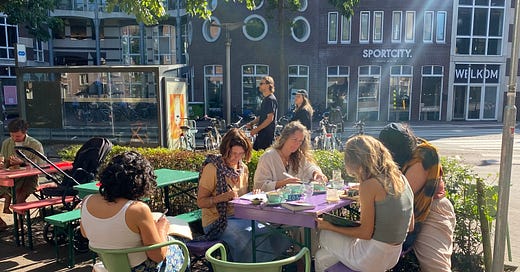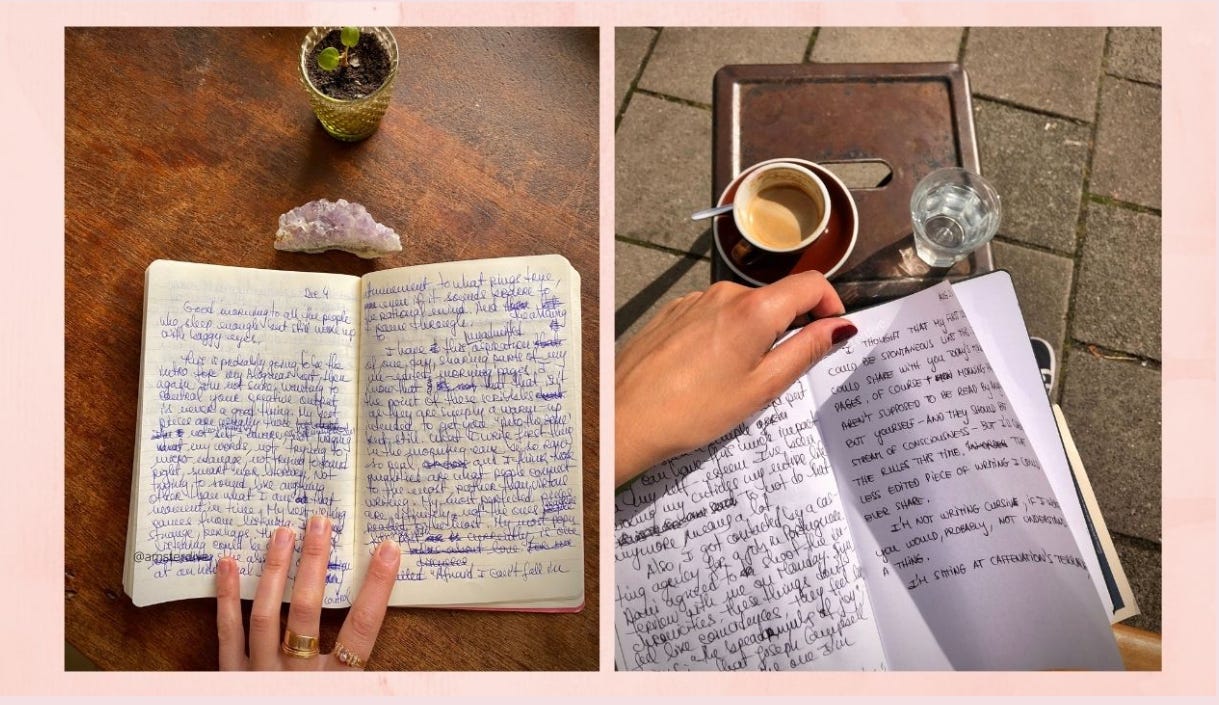Ana BC (Ana Before Cancer) would have avoided a book named after “The Artist’s Way.” A course in discovering and recovering your creative self? It sounded self-helpy. A true artist doesn’t need such a thing. I was naturally creative. Writing and performing were foundational to me. Creativity was the one thing I didn’t lack. My self importance — which was a disguise for a sense of insecurity, really — started crumbling down when I got told I had to undergo all these treatments for breast cancer.
Doctors started taking care of the physical aspect of the illness, but I needed help beyond that. Emotionally, I was completely frozen. I couldn’t create anymore. I needed help with this fundamental part of myself — the creative part — which is also where vitality resides. My creative self was shrouded in feelings of shame and guilt, and chronic self loathing, but I couldn’t understand why that was. It was unclear then what help could look like. Help ended up taking the shape of a book.
What a very humbling experience, accepting help is. It required getting rid of intellectual arrogance. Now, I was just like everyone else. Now everyone was a peer, and a possible creative collaborator. And this is where my passion for facilitating creative + sharing circles began.
Did I enjoy writing at all?
Julia Cameron writes in The Artist’s Way that she had made an early career out of being “Creative in spasms. Creative as an act of will and ego. Creative, yes, but in spurts, like blood from a severed carotid artery.” This rang true to me.
A decade of writing and all I knew was how to make these headlong dashes and hurl myself, against all odds, at the wall of whatever I was writing. If creativity was spiritual in any sense, it was only in its resemblance to a crucifixion. I fell upon the thorns of prose. I bled.” This was me too in the first years of blogging, so much so that I asked myself at different points if I enjoyed writing at all.
Relearning what sparks life within
Cameron developed a 12 week-long method for unleashing your creative self. This is equal parts developing containers for creation and self-therapy, and doing a number of creative exercises with the type of devotion one reserves for a spiritual practice.
This journey is supported by two main practices: the morning pages and the artist’s dates. The morning pages consist of three pages of stream of consciousness journaling done first thing in the morning. This is a practice that enables us to go beyond our judgemental mind — the overly critical part of ourselves that so often stands in the way of self-expression — and gets us used to stepping into mindful action.
The artist’s dates are dedicated time — away from screens — to explore any activity that strikes your fancy. These moments reawaken a spirit of playfulness that is so essential to creativity. Over time, these dates with yourself help you (re)discover what you’re interested in, what brings you a sense of joy, what sparks life within.
There is, of course, a chapter to read each week, a theme to delve deeper into, and different prompts to reflect on.
Creative practice, spiritual practice
The ability to be creative is one of the defining features of humankind. Creating awakes our minds and bodies, but what we feel when we enter a state of flow goes beyond that: it nourishes our spirit. What exactly happens to humans when they’re creating has a mysterious quality to it: it is not fully visible to the naked eye, it cannot be fully measured.
If we put the act of creativity in context — as opposed to looking at it from the individualistic lens that stresses the uniqueness of its creator — we understand that we are not at the center of anything when we create. Rather, we are co-creators (both in life and in our creative endeavors). When we accept that we don’t create in a vacuum we feel less isolated. We also feel less prone to isolating ourselves. What we speak of and to as creatives / artists is universal even when it’s niche.
The interesting thing about using creative practices to go deep within yourself is that, by so doing — especially if you go through The Artist’s Way in community — you end up decentering yourself from your craft. The “I who creates” becomes less important, it gives way to a sense of connectedness with “the whole”: people you’re on this journey with, a possible audience, nature, or the elements, God or a divine presence for some.
The Artist’s Way Circle
The Artist’s Way informs my artistic practice to this day. The framework is simple enough to be accessible to everyone, profound enough to remain relevant to practicing / professionalized artists.
My first attempt at The Artist’s Way was in 2020, but that happened during my first cancer stint and I didn’t go beyond the 3rd chapter. In April 2021, I committed to the journey with three other women. With each other’s support and accountability, we managed to go through the whole course.
Julia Cameron calls groups like this “creativity clusters” and she envisioned them as non-profit, “non-hierarchical, peer-run” groups for collective “creative recovery.” With this in mind — and because I know that so many of you are interested in this course — I decided to organize an online Artist’s Way circle, to provide a space for support and accountability to those who want to go on this journey together.
Our circle includes 12 Friday morning Google meet gatherings — corresponding to the 12 chapters of the book — with likeminded creative souls. Contribution works on a sliding scale — pay what your finances allow, no questions asked — either via Buy Me a Coffee, tikkie or similar.
Is The Artist’s Way for you?
Needless to say that what works for me may not work for you and vice-versa. I guess that, if you’re curious about this course, a good starting point is to see if Cameron’s words resonate with you. I leave you with some excerpts.
Many of us wish we were more creative. Many of us sense we are more creative, but unable to effectively tap that creativity. Our dreams elude us. Our lives feel somewhat flat. Often, we have great ideas, wonderful dreams, but are unable to actualize them for ourselves. Sometimes we have specific creative longings we would love to be able to fulfill – learning to play the piano, painting, taking an acting class, or writing. Sometimes our goal is more diffuse. We hunger for what might be called creative living – an expanding sense of creativity in our business lives, in sharing with our children, our spouse, our friends.
_
While there is no quick fix for instant, pain-free creativity, creative recovery (or discovery) is a teachable, trackable, spiritual process.
–
How do you know if you are creatively blocked? Jealousy is an excellent clue. Are there artists whom you resent? Do you tell yourself, “I could do that, if only…” Do you tell yourself that if only you took your creative potential seriously, you might:
Stop telling yourself, “It’s too late.”
Stop waiting until you make enough money to do something you’d really love.
Stop telling yourself, “It’s just my ego” whenever you yearn for a more creative life.
Stop telling yourself that dreams don’t matter, that they are only dreams and that you should be more sensible.
Stop fearing that your family and friends would think you’re crazy.
Stop telling yourself that creativity is a luxury and that you should be grateful for what you’ve got.
As you learn to recognize, nurture, and protect your inner artist, you will be able to move beyond pain and creative constriction. You will learn ways to recognize and resolve fear, remove emotional scar tissue, and strengthen your confidence. Damaging old ideas about creativity will be explored and discarded.
The Artist’s Way is like a spiral path. You will circle through some of the issues over and over, each time at a different level. There is no such thing as being done with an artistic life. Frustrations and rewards exist at all levels on the path.









I have lovely memories of that first time doing Artist’s Way with you! It was the very beginning of calling myself a writer, even though I’d already been writing for years. I still go back to Morning Pages when I need them.